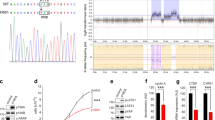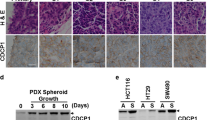Abstract
Obscurins, encoded by the single OBSCN gene, are giant cytoskeletal proteins with structural and regulatory roles. The OBSCN gene is highly mutated in different types of cancers. Loss of giant obscurins from breast epithelial cells confers them with a survival and growth advantage, following exposure to DNA-damaging agents. Here we demonstrate that the expression levels and subcellular distribution of giant obscurins are altered in human breast cancer biopsies compared with matched normal samples. Stable clones of non-tumorigenic MCF10A cells lacking giant obscurins fail to form adhesion junctions, undergo epithelial-to-mesenchymal transition and generate >100-μm mammospheres bearing markers of cancer-initiating cells. Obscurin-knockdown MCF10A cells display markedly increased motility as a sheet in 2-dimensional (2D) substrata and individually in confined spaces and invasion in 3D matrices. In line with these observations, actin filaments redistribute to extending filopodia where they exhibit increased dynamics. MCF10A cells that stably express the K-Ras oncogene and obscurin short hairpin RNA (shRNA), but not scramble control shRNA, exhibit increased primary tumor formation and lung colonization after subcutaneous and tail vein injections, respectively. Collectively, our findings reveal that loss of giant obscurins from breast epithelium results in disruption of the cell–cell contacts and acquisition of a mesenchymal phenotype that leads to enhanced tumorigenesis, migration and invasiveness in vitro and in vivo.
This is a preview of subscription content, access via your institution
Access options
Subscribe to this journal
Receive 50 print issues and online access
$259.00 per year
only $5.18 per issue
Buy this article
- Purchase on Springer Link
- Instant access to full article PDF
Prices may be subject to local taxes which are calculated during checkout






Similar content being viewed by others
Accession codes
References
Kontrogianni-Konstantopoulos A, Ackermann MA, Bowman AL, Yap SV, Bloch RJ . Muscle giants: molecular scaffolds in sarcomerogenesis. Physiol Rev 2009; 89: 1217–1267.
Kontrogianni-Konstantopoulos A, Bloch RJ . Obscurin: a multitasking muscle giant. J Muscle Res Cell Motil 2005; 26: 419–426.
Perry NA, Ackermann MA, Shriver M, Hu LY, Kontrogianni-Konstantopoulos A . Obscurins: unassuming giants enter the spotlight. IUBMB Life 2013; 65: 479–486.
Russell MW, Raeker MO, Korytkowski KA, Sonneman KJ . Identification, tissue expression and chromosomal localization of human Obscurin-MLCK, a member of the titin and Dbl families of myosin light chain kinases. Gene 2002; 282: 237–246.
Fukuzawa A, Idowu S, Gautel M . Complete human gene structure of obscurin: implications for isoform generation by differential splicing. J Muscle Res Cell Motil 2005; 26: 427–434.
Hu LY, Kontrogianni-Konstantopoulos A . The kinase domains of obscurin interact with intercellular adhesion proteins. FASEB J 2013; 27: 2001–2012.
Borisov AB, Raeker MO, Russell MW . Developmental expression and differential cellular localization of obscurin and obscurin-associated kinase in cardiac muscle cells. J Cell Biochem 2008; 103: 1621–1635.
Sjoblom T, Jones S, Wood LD, Parsons DW, Lin J, Barber TD et al. The consensus coding sequences of human breast and colorectal cancers. Science 2006; 314: 268–274.
Balakrishnan A, Bleeker FE, Lamba S, Rodolfo M, Daniotti M, Scarpa A et al. Novel somatic and germline mutations in cancer candidate genes in glioblastoma, melanoma, and pancreatic carcinoma. Cancer Res 2007; 67: 3545–3550.
Price ND, Trent J, El-Naggar AK, Cogdell D, Taylor E, Hunt KK et al. Highly accurate two-gene classifier for differentiating gastrointestinal stromal tumors and leiomyosarcomas. Proc Natl Acad Sci USA 2007; 104: 3414–3419.
Perry NA, Shriver M, Mameza MG, Grabias B, Balzer E, Kontrogianni-Konstantopoulos A . Loss of giant obscurins promotes breast epithelial cell survival through apoptotic resistance. FASEB J 2012; 26: 2764–2775.
Baum B, Georgiou M . Dynamics of adherens junctions in epithelial establishment, maintenance, and remodeling. J Cell Biol 2011; 192: 907–917.
Phillips TM, McBride WH, Pajonk F . The response of CD24(−/low)/CD44+ breast cancer-initiating cells to radiation. J Natl Cancer Inst 2006; 98: 1777–1785.
Foroni C, Broggini M, Generali D, Damia G . Epithelial-mesenchymal transition and breast cancer: role, molecular mechanisms and clinical impact. Cancer Treat Rev 2012; 38: 689–697.
Balzer EM, Tong Z, Paul CD, Hung WC, Stroka KM, Boggs AE et al. Physical confinement alters tumor cell adhesion and migration phenotypes. FASEB J 2012; 26: 4045–4056.
Hung WC, Chen SH, Paul CD, Stroka KM, Lo YC, Yang JT et al. Distinct signaling mechanisms regulate migration in unconfined versus confined spaces. J Cell Biol 2013; 202: 807–824.
Chen SH, Hung WC, Wang P, Paul C, Konstantopoulos K . Mesothelin binding to CA125/MUC16 promotes pancreatic cancer cell motility and invasion via MMP-7 activation. Sci Rep 2013; 3: 1870.
Tong Z, Balzer EM, Dallas MR, Hung WC, Stebe KJ, Konstantopoulos K . Chemotaxis of cell populations through confined spaces at single-cell resolution. PLoS One 2012; 7: e29211.
Hoenerhoff MJ, Chu I, Barkan D, Liu ZY, Datta S, Dimri GP et al. BMI1 cooperates with H-RAS to induce an aggressive breast cancer phenotype with brain metastases. Oncogene 2009; 28: 3022–3032.
Wang B, Soule HD, Miller FR . Transforming and oncogenic potential of activated c-Ha-ras in three immortalized human breast epithelial cell lines. Anticancer Res 1997; 17: 4387–4394.
Ciardiello F, Gottardis M, Basolo F, Pepe S, Normanno N, Dickson RB et al. Additive effects of c-erbB-2, c-Ha-ras, and transforming growth factor-alpha genes on in vitro transformation of human mammary epithelial cells. Mol Carcinog 1992; 6: 43–52.
Dallas MR, Liu G, Chen WC, Thomas SN, Wirtz D, Huso DL et al. Divergent roles of CD44 and carcinoembryonic antigen in colon cancer metastasis. FASEB J 2012; 26: 2648–2656.
Ericson K, Gan C, Cheong I, Rago C, Samuels Y, Velculescu VE et al. Genetic inactivation of AKT1, AKT2, and PDPK1 in human colorectal cancer cells clarifies their roles in tumor growth regulation. Proc Natl Acad Sci USA 2010; 107: 2598–2603.
Rago C, Huso DL, Diehl F, Karim B, Liu G, Papadopoulos N et al. Serial assessment of human tumor burdens in mice by the analysis of circulating DNA. Cancer Res 2007; 67: 9364–9370.
Hanahan D, Weinberg RA . Hallmarks of cancer: the next generation. Cell 2011; 144: 646–674.
Friedl P, Alexander S . Cancer invasion and the microenvironment: plasticity and reciprocity. Cell 2011; 147: 992–1009.
Knights AJ, Funnell AP, Crossley M, Pearson RC . Holding tight: cell junctions and cancer spread. Trends Cancer Res 2012; 8: 61–69.
Brasch J, Harrison OJ, Honig B, Shapiro L . Thinking outside the cell: how cadherins drive adhesion. Trends Cell Biol 2012; 22: 299–310.
Gottardi CJ, Wong E, Gumbiner BM . E-cadherin suppresses cellular transformation by inhibiting beta-catenin signaling in an adhesion-independent manner. J Cell Biol 2001; 153: 1049–1060.
Valenta T, Hausmann G, Basler K . The many faces and functions of beta-catenin. EMBO J 2012; 31: 2714–2736.
Holland JD, Klaus A, Garratt AN, Birchmeier W . Wnt signaling in stem and cancer stem cells. Curr Opin Cell Biol 2013; 25: 254–264.
Kontrogianni-Konstantopoulos A, Catino DH, Strong JC, Sutter S, Borisov AB, Pumplin DW et al. Obscurin modulates the assembly and organization of sarcomeres and the sarcoplasmic reticulum. FASEB J 2006; 20: 2102–2111.
Kontrogianni-Konstantopoulos A, Jones EM, Van Rossum DB, Bloch RJ . Obscurin is a ligand for small ankyrin 1 in skeletal muscle. Mol Biol Cell 2003; 14: 1138–1148.
Scheel C, Weinberg RA . Cancer stem cells and epithelial-mesenchymal transition: concepts and molecular links. Semin Cancer Biol 2012; 22: 396–403.
Drasin DJ, Robin TP, Ford HL . Breast cancer epithelial-to-mesenchymal transition: examining the functional consequences of plasticity. Breast Cancer Res 2011; 13: 226.
Taube JH, Herschkowitz JI, Komurov K, Zhou AY, Gupta S, Yang J et al. Core epithelial-to-mesenchymal transition interactome gene-expression signature is associated with claudin-low and metaplastic breast cancer subtypes. Proc Natl Acad Sci USA 2010; 107: 15449–15454.
Chiang AC, Massague J . Molecular basis of metastasis. N Engl J Med 2008; 359: 2814–2823.
Bravo-Cordero JJ, Hodgson L, Condeelis J . Directed cell invasion and migration during metastasis. Curr Opin Cell Biol 2012; 24: 277–283.
Arjonen A, Kaukonen R, Ivaska J . Filopodia and adhesion in cancer cell motility. Cell Adh Migr 2011; 5: 421–430.
Chhabra ES, Higgs HN . The many faces of actin: matching assembly factors with cellular structures. Nat Cell Biol 2007; 9: 1110–1121.
Hall A . Rho family GTPases. Biochem Soc Trans 2012; 40: 1378–1382.
Ford-Speelman DL, Roche JA, Bowman AL, Bloch RJ . The rho-guanine nucleotide exchange factor domain of obscurin activates rhoA signaling in skeletal muscle. Mol Biol Cell 2009; 20: 3905–3917.
Elenbaas B, Spirio L, Koerner F, Fleming MD, Zimonjic DB, Donaher JL et al. Human breast cancer cells generated by oncogenic transformation of primary mammary epithelial cells. Genes Dev 2001; 15: 50–65.
Ackermann MA, Hu LY, Bowman AL, Bloch RJ, Kontrogianni-Konstantopoulos A . Obscurin interacts with a novel isoform of MyBP-C slow at the periphery of the sarcomeric M-band and regulates thick filament assembly. Mol Biol Cell 2009; 20: 2963–2978.
Nanda A, Karim B, Peng Z, Liu G, Qiu W, Gan C et al. Tumor endothelial marker 1 (Tem1) functions in the growth and progression of abdominal tumors. Proc Natl Acad Sci USA 2006; 103: 3351–3356.
Samuels Y, Diaz LA Jr., Schmidt-Kittler O, Cummins JM, Delong L, Cheong I et al. Mutant PIK3CA promotes cell growth and invasion of human cancer cells. Cancer Cell 2005; 7: 561–573.
Acknowledgements
This work was supported by a Pilot Grant from The Johns Hopkins Physical Sciences-Oncology Center, The Johns Hopkins Institute for NanoBioTechnology (U54CA143868 to AK-K) and by awards from the National Science Foundation (Award NSF-1159823 to KK), the National Cancer Institute (Awards U54-CA143868 to KK; R01-CA186286 to KK; T32-CA130840 to KMS; F32-CA177756 to KMS; R01-CA154624 to SM and K01-CA166576 to MIV) and the Kleberg Foundation (to KK). Portions of this work are included in a United States patent pending, 14/221,755, filed on 21 March 2014.
Author information
Authors and Affiliations
Corresponding author
Ethics declarations
Competing interests
The authors declare no conflict of interest.
Additional information
Supplementary Information accompanies this paper on the Oncogene website
Supplementary information
Rights and permissions
About this article
Cite this article
Shriver, M., Stroka, K., Vitolo, M. et al. Loss of giant obscurins from breast epithelium promotes epithelial-to-mesenchymal transition, tumorigenicity and metastasis. Oncogene 34, 4248–4259 (2015). https://doi.org/10.1038/onc.2014.358
Received:
Revised:
Accepted:
Published:
Issue Date:
DOI: https://doi.org/10.1038/onc.2014.358
This article is cited by
-
Cellular senescence gene TACC3 associated with colorectal cancer risk via genetic and DNA methylated alteration
Archives of Toxicology (2024)
-
In Silico Pipeline to Identify Tumor-Specific Antigens for Cancer Immunotherapy Using Exome Sequencing Data
Phenomics (2023)
-
Microtubule disruption reduces metastasis more effectively than primary tumor growth
Breast Cancer Research (2022)
-
Genome-wide expression of the residual lung reacting to experimental Pneumonectomy
BMC Genomics (2021)
-
Deletion of obscurin immunoglobulin domains Ig58/59 leads to age-dependent cardiac remodeling and arrhythmia
Basic Research in Cardiology (2020)



